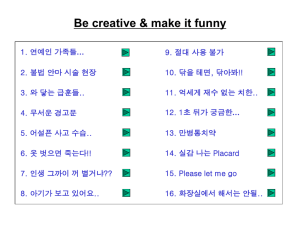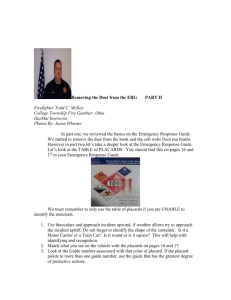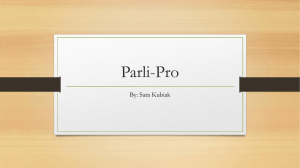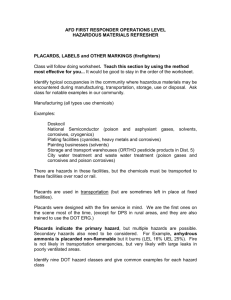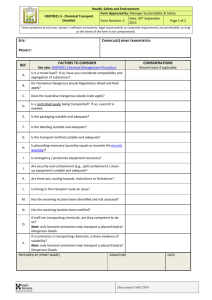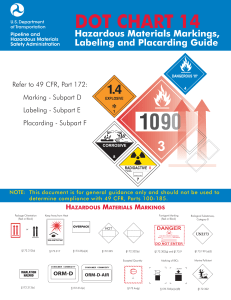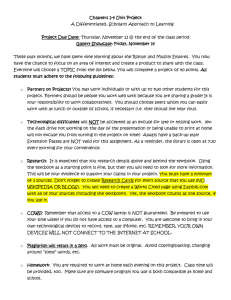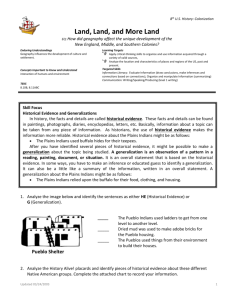Module 5 – Student Manual
advertisement
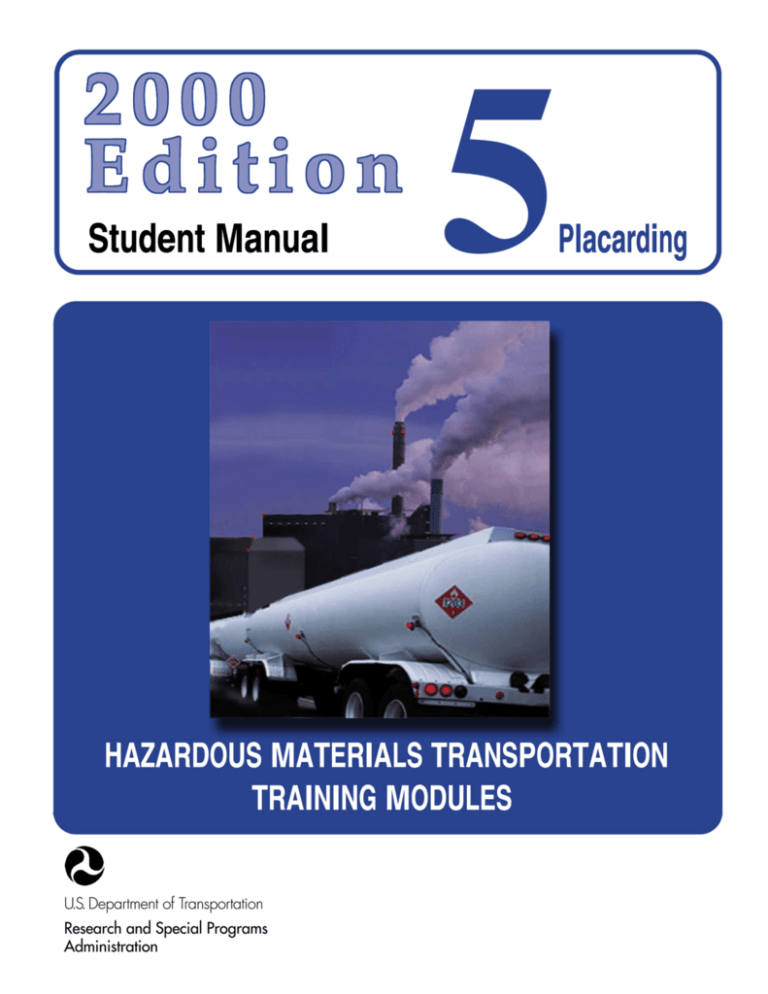
Module 5 – Student Manual Script Visual Narrative 1 Module 5 – Placarding 2 Unless the regulations tell you differently, each person who offers or transports a regulated hazardous material must comply with the placarding requirements. They are located in Subpart F of the HMR. 172.500(a) Module 5 2000 Edition 1 Module 5 – Student Manual 3 The placarding requirements do not apply to • • • • • • Small quantities, Limited Quantity (Ltd. Qty.), Infectious substances, Other Regulated Material-D (ORM-D), Combustible liquids in non-bulk packaging, and materials prepared according to 173.13. 172.500(b)(1)-(6); 173.4; 173.13 STUDENT RESPONSE NOTE 1-3 Placards are not required for , limited quantities, ORM-Ds, combustible liquids in non-bulk packagings, small quantities, and materials prepared according to 173.13. 4 Placards may not be placed or displayed on a transport vehicle, portable tank or freight container unless: • • • the transported material is a hazardous material, the placard represents a hazard of the material, and the placarding conforms to the regulations. 172.502(a)(1) STUDENT RESPONSE NOTE 4 Do not placard a vehicle or freight container unless it’s transporting a and the placard correctly identifies the hazard. 2 2000 Edition Module 5 Module 5 – Student Manual 5 Placards must clearly communicate the hazard of the material being transported. This is crucial in an emergency situation. Therefore, the required placard(s) must have no visual competition. In other words, do not use any sign or device that by its color, shape, content or design may be confused with a placard on a transport vehicle, portable tank or freight container. 172.502(a)(2) STUDENT RESPONSE NOTE 5 Do not place a color, shape or design on a vehicle or container that could be confused with a . 6 These restrictions do not apply to the display of an identification number on a white square-on-point configuration prescribed by 172.336(b). 172.502(b)(2) STUDENT RESPONSE NOTE 6 Restrictions do not apply to the display of an on a white square-on-point configuration. Module 5 2000 Edition 3 Module 5 – Student Manual 7 There are exceptions to these prohibitions. They do not apply if the placards used are in conformance with the Transportation of Dangerous Goods (TDG) Regulations, the International Maritime Dangerous Goods (IMDG) Code, or UN Recommendations. 172.502(b)(1) STUDENT RESPONSE NOTE 7 Placards in conformance with Canada’s Regulations, the IMDG Code, or the UN Recommendations may be used in place of the HMR placards. 8 Certain shipments from Canada and through the United States may also display the Canadian Corrosive Gas placard. 172.502(b)(1) STUDENT RESPONSE NOTE 8 The 4 Gas placard is acceptable on shipments originating in Canada. 2000 Edition Module 5 Module 5 – Student Manual 9 Placards must be displayed on each end and each side of a bulk packaging, freight container, unit load device, transport vehicle and rail car containing any quantity of hazardous material, unless the HMR says otherwise. 172.504(a) STUDENT RESPONSE NOTE 9 Except as otherwise provided, each and each end of a transport vehicle or freight container containing any quantity of hazardous material, must be placarded. 10 There are two placarding tables in 172.504(e). Do not confuse these tables with the Hazardous Materials Table in 172.101. When determining which placards must be used and what options are available, both placarding tables must be considered. It is important to keep the two placarding tables separate when determining placarding requirements. 172.504(e) STUDENT RESPONSE NOTE 10 The Hazardous Materials Table is in 172.101. The placarding tables, Table 1 and Table 2, are in Module 5 . 2000 Edition 5 Module 5 – Student Manual 11 First, we’ll look at the basic placarding requirements. Then, we’ll look at some of the “unless otherwise provided” exceptions and options. 172.504(a) Student Activity Locate the two placarding tables in 172.504(e). Let’s begin with placarding Table 1. 172.504(e) 12 Placarding Table 1 is straight forward. Any quantity of any hazardous material listed in Table 1 requires placarding. Pay attention to the limitations in parentheses for Divisions 5.2, 6.1 and Class 7. 172.504(e) STUDENT RESPONSE NOTE 11-12 Always consult the in parentheses to Table 1 when determining if placards are required. 13 For example, the exception for Class 7 in Table 1 states “(Radioactive Yellow III label only).” The footnote to Table 1, notes that a placard is also required for exclusive use shipments of low specific activity material when shipped in accordance with 173.427. 172.504(e) 6 2000 Edition Module 5 Module 5 – Student Manual 14 If a shipment of radioactive material is labeled WHITE I or YELLOW II, placarding is not required. 172.504(e) STUDENT RESPONSE NOTE 13-14 label. No placard is required if Placard if the package has a the package has a RADIOACTIVE WHITE I or RADIOACTIVE YELLOW II label. 15 Each motor vehicle used to transport a package of highway route controlled quantity radioactive material, as defined in 173.403, must be placarded. Display the RADIOACTIVE placard on a square white background. 172.507(a); 172.527 Module 5 2000 Edition 7 Module 5 – Student Manual 16 Placarding Table 2 lists the remainder of the hazardous material classes that require placards. However, Table 2 materials require placarding only when the aggregate gross weight of all hazardous materials on the transport vehicle or in the freight container is 454 kg (1,001 lbs) or more. Transport vehicles and freight containers transporting less than 454 kg (1,001 lbs) aggregate gross weight of Table 2 materials may be placarded. Placards are not required, however. 172.504(c)(1)-(2) STUDENT RESPONSE NOTE 15-16 Hazardous materials listed in Table 2 must have an aggregate gross weight of 454 kg ( ) or more before a placard is required. 17 Additional exceptions and options are provided to both placarding tables in 172.504(f). 172.504(f) 8 2000 Edition Module 5 Module 5 – Student Manual 18 For example, a vehicle containing both Division 1.1 and 1.2 explosives that is placarded with EXPLOSIVES 1.1 placards as required, does not need to be placarded with EXPLOSIVES 1.2 placards. 172.504(f)(1) 19 Let’s look at another option. A FLAMMABLE placard may be used in place of a COMBUSTIBLE placard on a cargo tank or portable tank, or a compartmented tank car containing both flammable and combustible liquids. 172.504(f)(2) 20 Look at the entry for Division 1.4 explosives in placarding Table 2. The required placard is EXPLOSIVES 1.4. Now look at 172.504(f)(6). The EXPLOSIVES 1.4 placard is not required for those Division 1.4 materials in Compatibility Group S (1.4S) when they are not required to be labeled 1.4S. 172.504(f)(6) Student Activity Let’s compare a 454 kg (1,001 lbs) shipment of empty primed grenades and a 454 kg (1,001 lbs) shipment of fuse lighters. Both “Grenades, empty primed,” and “Lighters, fuse,” are listed in the HMT. Both are in compatibility Group S (1.4S). But only “Lighters, fuse,” require a 1.4S label. See Column 6 of the HMT. Module 5 2000 Edition 9 Module 5 – Student Manual 21 The “Lighters, fuse” shipment requires an EXPLOSIVES 1.4 placard since • • the package must be labeled Explosive 1.4S, and the shipment does not weigh less than 454 kg (1,001 lbs). 172.504(f)(6) 22 The “Grenades, empty primed,” shipment does not require a placard even though it weighs 454 kg (1,001 lbs). That’s because the material does not require a label. 172.504(f)(6) STUDENT RESPONSE NOTE 17-22 When placarding Table 2 hazardous materials affected by 172.504(f)(6), both labeling and 10 of 454 kg (1,001 lbs) or more must be considered. 2000 Edition Module 5 Module 5 – Student Manual 23 If a transport vehicle or freight container carries non-bulk packages containing two or more hazard classes from Table 2 requiring different placards, the DANGEROUS placard may be used in place of the hazard class placards. 172.504(b) 24 For example, a transport vehicle is carrying a combined shipment consisting of 454 kg (1,001 lbs) Class 3 (flammable liquid), 364 kg (800 lbs) of Class 8 (corrosives) and 136 kg (300 lbs) of nonflammable gas. Instead of the placards required for each class, the DANGEROUS placard may be used on the transport vehicle. 172.504(b) 25 The specific Table 2 placard must be used when 1,000 kg (2,205 lbs) or more of one class of hazardous material is loaded at one facility. In this case, the DANGEROUS placard may not be used for that material. 172.504(b) Module 5 2000 Edition 11 Module 5 – Student Manual 26 Two shipments of hazardous materials loaded at one facility are displayed in the visual. Each shipment is over 1,000 kg (2,205 lbs). The hazard classes are not the same. Therefore, the vehicle would require placarding specified for each hazard class. The DANGEROUS placard may not be used with these shipments. If the two shipments individually weighed less than 1,000 kg (2,205 lbs), you could use either the placards specified for the individual materials or the DANGEROUS placard. This is true whether loaded at the same or separate facilities. The 1,000 kg (2,205 lbs) rule was enacted to provide more specific identification of potential hazards of materials in mixed loads. However, it only applies when the 1,000 kg (2,205 lbs) of one hazard class are loaded at one facility. 172.504(b) STUDENT RESPONSE NOTE 23-26 Use the specific placard from Table 2 when 1,000 kg (2,205 lbs) or more of one hazard class are loaded at one facility. Do not use the placard for these shipments! 27 The DANGEROUS placard may not be used on a cargo tank, portable tank or tank car. Instead, the specific placard for each hazardous material must be applied. In addition, the DANGEROUS placard may not be used when placarding Table 1 materials. 172.504(a)-(b) 12 2000 Edition Module 5 Module 5 – Student Manual STUDENT RESPONSE NOTE 27 The DANGEROUS placard may not be used for materials listed in placarding Table 1. The DANGEROUS placard may not be used on , portable tanks or tank cars. 28 No placard is required for Table 2 material when the gross weight is less than 454 kg (1,001 lbs). Exceptions: You must placard Table 2 material when: • • • • shipped in bulk packages such as portable tanks, cargo tanks, or tank cars; shipped by air or water; identified on a shipping paper as a “Poison-Inhalation Hazard;” or the material has a subsidiary hazard of “DANGEROUS WHEN WET.” Poison or toxic-inhalation hazard materials will be discussed later in this module. 172.504(c) STUDENT RESPONSE NOTE 28 No placard is required for less than 454 kg (1,001 lbs) of materials. Placards are required for all Table 2 materials shipped in bulk packagings, by air or water, and for poison-inhalation hazard materials. Module 5 2000 Edition 13 Module 5 – Student Manual 29 When determining placarding requirements, it is not necessary to include the weight of any non-bulk packaging that contains only residue of a Table 2 hazardous material. 172.504(d) Student Activity Turn to Placarding Work Project P-1 on page 28 in your Student Manual. When you have completed and checked your work for accuracy, either review the work project with the instructor or check the answers on page 40. Please pause the presentation and complete this Student Activity. 30 When a shipper offers a hazardous material to a carrier for highway transportation, the shipper must also offer the required placards, unless the carrier’s vehicle is already properly placarded for the material. The motor carrier may not transport the hazardous material unless the proper placards are affixed to the vehicle. 172.506(a) 14 2000 Edition Module 5 Module 5 – Student Manual 31 A different approach is provided for placarding a hazardous materials shipment offered in a bulk package. The person offering this hazardous material must affix the required placards before the shipment is offered. 172.508(a); 172.514(a) 32 However, a portable tank of less than 3,785 liters (1,000 gals) capacity needs to be placarded on only two opposite sides or labeled on at least two sides or two ends as provided in 172.406(e). 172.514(c)(1) 33 For rail transportation, placards may be displayed on motor vehicles, transport containers or portable tanks instead of the rail car itself. If none of the transported vehicles or containers require placarding, no placard is required on the rail car. 172.504(c)(2); 172.508(a) STUDENT RESPONSE NOTE 29-33 For transportation by , placards may be displayed on motor vehicle, transport container or portable tank instead of the rail car. Module 5 2000 Edition 15 Module 5 – Student Manual 34 Each bulk packaging, including a cargo tank, or portable tank, required to be placarded when it contained a hazardous material, must remain placarded when it is empty and has not been cleaned and purged, or reloaded with a nonregulated material or a hazardous material requiring a different placard. The placard must be removed if the bulk packaging is reloaded with a nonregulated material or a hazardous material that requires a different placard. The placard must be removed once the bulk packaging is cleaned and purged of all potentially hazardous vapors. 172.514(b) STUDENT RESPONSE NOTE 34 Keep the placard on emptied bulk packaging until: and purged or • sufficiently • reloaded with a nonregulated material or a hazardous material requiring a different placard. 35 Placarding also applies to freight containers and unit load devices. A freight container is a reusable container that has a volume greater than 1.8 cubic meters (64 cubic feet ) and is designed to be lifted with its contents intact. It is intended primarily for containment of packages during transportation. 171.8, 172.504(a) 16 2000 Edition Module 5 Module 5 – Student Manual 36 A unit load device can be any type of freight container, including an aircraft pallet with a net or an aircraft pallet with a net over an igloo. 171.8 37 When placards are required, placard both ends and both sides of freight containers and unit load devices (ULD) of 18 cubic meters (640 cubic feet) capacity or more. When the aggregate gross weight of a Table 2 material in a freight container or unit load device is less than 454 kg (1,001 lbs), placards are not required for the motor vehicles transporting the freight container or ULD. 172.512(a), (a)(1) STUDENT RESPONSE NOTE 35-37 When required, both ends and both sides of freight containers and unit load devices that have a capacity of 18 cubic meters (640 cubic feet) or more. 38 Placards are not required when these same containers and devices are transported by air only, provided that they meet the International Civil Aviation Organization (ICAO) Technical Instructions. Also, the container or device must be labeled or marked with a tag, as shown in this visual. 172.512(a)(3) Module 5 2000 Edition 17 Module 5 – Student Manual 39 What if these containers and devices are less than 18 cubic meters (640 cubic feet) capacity and are offered and transported by air only? The person who offers or loads the hazardous material may either affix one placard or two labels on at least two ends or two sides. 172.512(b) 40 When transported by air, a freight container or unit load device with a capacity less than 18 cubic meters (640 cubic feet) of RADIOACTIVE YELLOW III-labeled material must display one RADIOACTIVE placard and two RADIOACTIVE YELLOW III labels, as seen here, or 172.512(b)(2) 41 be identified as containing a hazardous material by a label or tag, in accordance with the ICAO Technical Instructions. 172.512(b)(3) 18 2000 Edition Module 5 Module 5 – Student Manual 42 Each placard on a motor vehicle or rail car must be readily visible from the direction it faces. Placards must be on each side and each end. If coupled to another motor vehicle or rail car, visibility is not required from the direction it faces. Here we see a tractor semi-trailer with the placard affixed to the front of the trailer but the placard is partially blocked by the cab. This is permitted. 172.516(a) 43 The required placard on the front of a motor vehicle may be on the front of a truck tractor instead of, or in addition to, the placard on the attached cargo body. 172.516(b) 44 If visibility requirements are met, freight containers or portable tanks may be placarded instead of the motor vehicle. But, if a portable tank or freight container requiring placarding is inside a closed transport vehicle, the van type trailer must also be placarded. 172.516(a) Module 5 2000 Edition 19 Module 5 – Student Manual 45 Each placard must be securely attached and maintained in good condition. Placards must be located clear of appurtenances and devices, away from dirt and water from wheels and at least three inches from any detracting markings. The words and/or numbers on the placard(s) must be displayed horizontally. 172.516(c) STUDENT RESPONSE NOTE 38-45 Placards must be placed so they are and at least three inches from other markings. Words and numbers must be shown horizontally. 46 There are some special placarding provisions that the shipper and the carrier must follow. The first special requirement is for any amount of certain poisonous (toxic) materials. 172.505 47 When the shipping paper describes a material as a “ToxicInhalation Hazard” or “Poison- Inhalation Hazard,” the POISON INHALATION HAZARD or POISON GAS placard must be displayed on each side and each end of the transport vehicle, portable tank or freight container. The placard must be displayed in addition to any other required placard, however, if the primary hazard is Poison or Toxic, duplication of the Poison-Inhalation Hazard or Poison Gas placard is not required. 172.505 20 2000 Edition Module 5 Module 5 – Student Manual 48 Example: A Class 3 material (Flammable liquid) is offered for transportation. The shipping paper bears the notation, “Poison-Inhalation Hazard”. Therefore, the transport vehicle, freight container or portable tank must be placarded FLAMMABLE and POISON-INHALATION HAZARD. 172.505(a) STUDENT RESPONSE NOTE 46-48 A POISON-INHALATION HAZARD placard must appear on each side and each end of a transport vehicle, portable tank or freight container for of “Poison-Inhalation Hazard” material. 49 When displayed on a railcar, the following placards must be displayed on a square white background: • • • • • Module 5 Division 1.1 Explosive; Division 1.2 Explosive; Division 2.3, Hazard Zone A; Division 6.1, PG I, Hazard Zone A; Division 2.1 in DOT 113 tank cars. 172.510(a) 2000 Edition 21 Module 5 – Student Manual STUDENT RESPONSE NOTE 49 When displayed on a rail car, the following placards must be displayed on a white background: • Division 1.1 Explosive; • Division 1.2 Explosive; • Division 2.3, Hazard Zone A; • Division 6.1, PG I, Hazard Zone A; • Division 2.1 in DOT 113 tank cars. 50 Rail cars containing chemical ammunition that is both a Division 1.1 or 1.2 explosive and a PIH material, must be placarded EXPLOSIVES 1.1 OR 1.2 AND POISON GAS or POISON-INHALATION HAZARD. 172.510(b) Student Activity Turn to Placarding Work Project P-2 on page 31 in your student manual. When you have completed and checked your work for accuracy, either review the work project with the instructor or check the answers on page 41. Please pause the presentation and complete this Student Activity. 22 2000 Edition Module 5 Module 5 – Student Manual 51 Placards may be modified in certain instances. The word “GASOLINE” may be used in place of the word “FLAMMABLE” on the placard of a cargo or portable tank transporting gasoline by highway. As long as fuel oil is not classed as Flammable liquid, the words “FUEL OIL” may be used in place of the word “COMBUSTIBLE” on the placard. However, the fuel oil must be in a cargo or portable tank transported by highway. 172.542(c); 172.544(c) 52 Any sign, advertisement, slogans such as “Drive Safely” and other placard “look-a-likes” must be removed or covered by October 1, 2001. Placards specified in the December 21, 1990 HMR may be used for highway transportation only until October 1, 2001. Please review the Placard Substitution Table in 171.14(b). 171.14(b);172.502(b)(3) STUDENT RESPONSE NOTE 50-52 Until October 1, 2001, placards referred to in 171.14(b) may be used for transportation only. Module 5 2000 Edition 23 Module 5 – Student Manual 53 In summary, placarding is the joint responsibility of the shipper and the carrier. Those who offer, load and/or transport hazardous material must comply with the placarding regulations. If the required placard is missing, or damaged, no matter what the reason, the shipment must not be transported. It’s your responsibility, as shipper or carrier, to make sure the correct placards are offered or affixed before the shipment is transported. Since placarding is complex and crucial, do not rely solely on the information in this program. Use the Hazardous Materials Regulations and remember to refer to both placarding Table 1 and Table 2 and the exceptions in 172.504(f). STUDENT RESPONSE NOTE 53 When determining placarding requirements and placarding options, always refer to both placarding and the exceptions. 54 If you are a shipper, make sure you offer or affix the required placards for the material before you ship hazardous materials. If you are a carrier, know what you are accepting for transportation. If the placards are not correct, do not accept the shipment! Remember: Shipments that comply with the Hazardous Material Regulations make transportation of hazardous material safer for everyone, including you. 171.2 24 2000 Edition Module 5 Module 5 – Student Manual 55 This concludes the instruction and practice portion of this module. Now is the time to assess how well the module taught you. This will be an open book test. There are no “trick” questions. Unless instructed otherwise, please complete the Module 5 Test. The Module 5 Test begins on page 34 of your Student Manual. Instructor Note: Please check test answers, record scores and update training records. Review test results with students. STUDENT RESPONSE NOTE ANSWERS begin on page 38. WORK PROJECT ANSWERS begin on page 40. Module 5 2000 Edition 25 Module 5 – Student Manual Placarding Summary Placards not required for • Infectious substances, ORM-D materials and Limited Quantities; • Combustible Liquids in non-bulk packagings; • Non-bulk packagings with residue of Table 2 material; • Small Quantities; • Any material excepted from placarding in a packaging section. 172.500(b)(1)(2)(3) 172.500(b)(6) 172.504(d) 173.4, 172.500(b)(5) 173.159(e),173.320(a) Placards required for • Any amount of Table 1 material. Check limitations. • Any amount of material identified on a shipping paper as “Poison-Inhalation Hazard.” Placard “POISON-INHALATION HAZARD” in addition to any other required placard(s). • Any shipment of 1,000 kg (2,205 lbs) or more of one class of Table 2 material loaded at one loading point. Use placard specified in table. • Transport vehicle or freight containers with 454 kg (1,001 lbs) or more aggregate gross weight of Table 2 material. Use placard(s) specified in Table 2 or DANGEROUS placard, if authorized. Note: Do not combine materials from Table 1 and Table 2 when determining placarding requirements. 26 2000 Edition Module 5 Module 5 – Student Manual Compliance Checklist Placarding Placards Violations 49 CFR 1. Applicability 172.500 2. Prohibited Placarding 172.502 3. Basic Requirement 172.504 4. Poison Inhalation Hazard 172.505 5. Shipper Requirement 172.506(a) 6. Carrier Requirement 172.506(a)(1) 7. Highway Route Control Quantity (RAM)* 172.507(a) 8. Rail Basic Requirement 172.508 9. Rail Special Provisions 172.510 10. Freight Containers 18 cubic meters (640 cu ft) or more 172.512(a) 11. Freight Containers less than 18 cubic meters (640 cu ft) 172.512(b) 12. Cargo Tanks/Portable Tanks 172.514 13. Visibility and Display 172.516 14. General Specifications for Placards 172.519 * Radioactive Materials Module 5 2000 Edition 27 Module 5 – Student Manual Work Projects Placarding Work Project Work Project P-1 To the Instructor The objective of this work project is to provide a practical placarding exercise. The student is provided with transportation situations where hazardous material may or may not require placarding. Directions to the Student(s) Work Project P-1 has seven situations relating to the transportation of hazardous material. Determine what placard(s), if any, must be displayed and/or offered. Following each placarding situation, there is a space to write in the name of the placard and the HMR reference. If no placards are required, write “none”. The DANGEROUS placard may be used when appropriate. Self-Evaluation The work project will evaluate your skill and facility in the use of the HMR to determine placarding requirements. When you have completed and checked your work for accuracy, either review the work project with the instructor or check the answers on page 40. 28 2000 Edition Module 5 Module 5 – Student Manual Placarding Work Project Work Project P-1 1. A truck is transporting: • • 204 kg (450 lbs) of Class 7 (radioactive material) labeled YELLOW-III; 227 kg (500 lbs) of Benzene, a Class 3 (flammable liquid). Placard(s) Required Reference(s) 2. A truck is transporting: • • • 363 kg (800 lbs) of Class 8 (corrosive material), 9.1 kg (20 lbs) of Division 2.2 (nonflammable gas), 227 kg (500 lbs) of Class 3 (flammable liquid). Placard(s) Required Reference(s) 3. A rail car is transporting: • • 2,359 kg (5,200 lbs) of Class 3 (flammable liquid), packaged and described as limited quantity; fifty 208 liter (55 gallon) empty drums which have residue of Class 8 (corrosive material). Placard(s) Required Reference(s) 4. A truck is transporting: • • • 363 kg (800 lbs) of ORM-D; 136 liters (300 lbs) of Class 3 (flammable liquid), packaged as small quantitie; 680 kg (1,500 lbs) of Division 6.1 (poison), PG III. Placard(s) Required Reference(s) Module 5 2000 Edition 29 Module 5 – Student Manual 5. A truck is transporting: • • • 2,722 kg (6,000 lbs) of Class 3 (flammable liquid), loaded at one facility; 227 kg (500 lbs) of Division 4.3 DANGEROUS WHEN WET; 91 kg (200 lbs) of Division 5.1 (Oxidizer). Placard(s) Required Reference(s) 6. A truck is transporting: • • • 2,722 kg (6,000 lbs) of Division 2.2 (Argon, compressed), packaged in 151 L (40 gallon) capacity cylinders, loaded at one facility; 200 kg (440 lbs) of Division 6.1 (Poison), PG II; 45 kg (99 lbs) of Class 8 (corrosive material). Placard(s) Required Preference(s) 7. A cargo tank is transporting: • • 7,571 liters (2,000 gals) of Class 3 (flammable liquid); 1,892 liters (500 gals) of Division 6.1 (Poison), PG I, liquid. Placard(s) Required Reference(s) 30 2000 Edition Module 5 Module 5 – Student Manual Placarding Work Project Work Project P-2 To the Instructor The objective of this work project is to provide a practical placarding exercise. The student is provided with transportation situations where hazardous material may or may not require placarding. Directions to the Student(s) Work Project P-2 has seven situations relating to the transportation of hazardous materials. Determine what placard(s), if any, must be displayed and/or offered. Following each placarding situation, there is a space to write in the name of the placard and the regulation reference. If no placards are required, write “none”. The DANGEROUS placard may be used when appropriate. Self-Evaluation The work project will evaluate your skill and facility in the use of the HMR to determine placarding requirements. When you have completed and checked your work for accuracy, either review the work project with the instructor or check the answers on page 41. Module 5 2000 Edition 31 Module 5 – Student Manual Placarding Work Project Work Project P-2 1. A shipper offers to a motor carrier: • • • 182 kg (400 lbs) of Class 9 (miscellaneous hazardous materials), 227 kg (500 lbs) of Division 2.2 (nonflammable gas), 363 kg (800 lbs) of Division 5.1 (Oxidizer). Placard(s) Required Reference(s) 2. A rail car is loaded with a van-type trailer placarded FLAMMABLE containing 1,633 liters (431 gallons) of Class 3 (flammable liquid). Placard(s) Required Reference(s) 3. A cargo tank is returning empty from a delivery of 22,700 liters (5,997 gals) of gasoline, a Class 3 liquid. Placard(s) Required Reference(s) 4. A freight container with a capacity of less than 18 cubic meters (640 cubic feet) contains 23 kg (51 lbs) of Division 4.1 (flammable solid), and is being transported only by air. Placard(s) Required Reference(s) 5. A truck is transporting: • • 363 kg (800 lbs) of Class 3 (flammable liquid), and 23 kg (51 lbs) of Class 8 (corrosive material). The shipping paper description indicates the flammable liquid meets the Poison-Inhalation Hazard criteria. Placard(s) Required Reference(s) 32 2000 Edition Module 5 Module 5 – Student Manual 6. A rail tank car is returning empty with a residue of Class 3 (flammable liquid) material. Placard(s) Required Reference(s) 7. A freight container of 19 cubic meters (670 cubic feet) capacity is transporting 159 kg (350 lbs) of Class 3 (flammable liquid) material loaded inside a 208 L (55 gallon) drum, by highway. Placard(s) Required Reference(s) Module 5 2000 Edition 33 Module 5 – Student Manual Module 5 Test 1. The placarding requirements do not apply to a. b. c. d. e. 2. must be considered when determining placarding requirements must not be transported may be transported only after being cleaned and purged need not be considered in determining placarding requirements offer the required placards affix the required placards require the carrier to affix the required placards require the carrier to have a supply of placards in the power unit True False A rail carrier may not accept a rail car containing a hazardous material requiring placarding unless the placards for the hazardous material are affixed as required. a. b. 34 . Except for bulk packagings and hazardous materials subject to 172.505, placards are not required for Table 2 materials on a rail car loaded with vehicles or freight containers that don’t require placards. a. b. 6. 172.505 172.502 172.504 172.506 172.514 Each person who offers for transportation a cargo tank containing a hazardous material shall . a. b. c. d. 5. . A non-bulk packaging that contains only residue of a Class 3 liquid a. b. c. d. 4. infectious substances hazardous material classed as ORM-D small quantities of certain hazard classes limited quantities (Ltd. Qty.), when noted on shipping document all of the above The prohibited placarding requirements can be found in a. b. c. d. e. 3. . True False 2000 Edition Module 5 Module 5 – Student Manual 7. Three hundred packages of Division 5.1 (Oxidizer-labeled) material weighing 272 kg (600 lbs) total are being offered by shipper “A” for transportation by motor vehicle. The shipper must offer the appropriate placards. a. b. 8. Shipper “B” offers 318 kg (700 lbs) of Division 6.1 (Poison-labeled), PG III, material to the same motor carrier in question 7. Shipper “B” must offer the appropriate placards. a. b. 9. True False True False Based on the information in questions 7 and 8, the carrier may affix which of the following placards? a. b. c. d. e. POISON and DANGEROUS OXIDIZER and DANGEROUS DANGEROUS POISON and OXIDIZER Any of the above 10. You are the shipper. Your shipping paper reflects 10,000 kg (22,046 lbs) of Class 3 (flammable liquid) material in case lots noted as “Ltd. Qty.” What placard must be offered for this shipment? a. b. c. d. FLAMMABLE placard No placard is required DANGEROUS placard COMBUSTIBLE placard 11. What placard is required for a 0.45 kg (one-pound) package of Division 1.1 explosives? a. b. c. d. DANGEROUS None required - less than 454 kg (1,001 lbs) EXPLOSIVES 1.1 DANGEROUS WHEN WET 12. A transport vehicle containing packages labeled “Radioactive Yellow III” being transported with packages labeled “Division 1.3 (explosives)” must be placarded . a. b. c. d. Module 5 DANGEROUS RADIOACTIVE RADIOACTIVE AND EXPLOSIVE 1.3 EXPLOSIVE 1.3 2000 Edition 35 Module 5 – Student Manual 13. A cargo tank used to transport 30,283 liters (8,000 gals) of gasoline, Class 3 (flammable liquid) material, is returning “empty.” The cargo tank must be placarded . a. b. c. d. FLAMMABLE LIQUID DANGEROUS FLAMMABLE RESIDUE 14. A transport vehicle carrying a Class 3 (flammable liquid) material and described on a shipping paper as “Poison-Inhalation Hazard” must be placarded . a. b. c. d. DANGEROUS POISON-INHALATION HAZARD FLAMMABLE AND POISON-INHALATION HAZARD FLAMMABLE 15. A Class 8 (corrosive) material [4,000 kg (8,800 lbs)] and a Class 3 (flammable liquid) material, [3,629 liters (958 gals)] are loaded at one loading facility. What placard(s) must be displayed on the transport vehicle? a. b. c. d. CORROSIVE FLAMMABLE DANGEROUS CORROSIVE and FLAMMABLE 16. A Class 3 liquid [1,814 kg (3,999 lbs)] is loaded into a freight container with a capacity of 18 cubic meters (640 cubic feet) or more. The freight container must be placarded . a. b. c. d. DANGEROUS FLAMMABLE FLAMMABLE LIQUID no placard required 17. No placard is required for an 18 cubic meters (640 cubic feet) capacity or less freight container of hazardous material not offered for air transportation. However, the container must be labeled on . a. b. c. d. 36 one end one side both sides or both ends no label required 2000 Edition Module 5 Module 5 – Student Manual 18. A truck that contains 4.5 kg (10 lbs) of Class 7 (radioactive material, n.o.s.), labeled Yellow-II in non-bulk packaging; 2,722 kg (6,000 lbs) of Acetone, Class 3 liquid, loaded at one point; and 9.1 kg (20 lbs) of Potassium cyanide solid, Division 6.1 (Poison), PG I, must be placarded . a. b. c. d. FLAMMABLE RADIOACTIVE and FLAMMABLE RADIOACTIVE, FLAMMABLE and POISON FLAMMABLE and either POISON or DANGEROUS 19. The POISON placard would not be appropriate for hazardous material classed: a. b. c. d. Division 2.3 Class 3, Poison Inhalation Division 6.1 a and b 20. The EXPLOSIVES 1.2 placard is not required if the transport vehicle or freight container contains Div. 1.2 and Div. 1.1 explosives and is placarded EXPLOSIVES 1.1. a. b. True False 21. A truck containing 2,721 kg (5,986 lbs) of Class 2.2 (Non-flammable gas) loaded at one facility, 227 kg (500 lbs) of Div. 1.3 Explosive and 4,536 kg (10,000 lbs) of ORM-D must be placarded . a. b. c. d. Module 5 NON-FLAMMABLE GAS, EXPLOSIVES 1.3, and ORM NON-FLAMMABLE GAS, AND EXPLOSIVES 1.3 NON-FLAMMABLE GAS, AND DANGEROUS DANGEROUS 2000 Edition 37 Module 5 – Student Manual Answer Sheets Student Response Note Answers 38 1-3 Placards are not required for Infectious substances, limited quantities, ORM-Ds, combustible liquids in non-bulk packagings, small quantities, and materials prepared according to 173.13. 4 Do not placard a vehicle or freight container unless it’s transporting a hazardous material and the placard correctly identifies the hazard. 5 Do not place a color, shape or design on a vehicle or container that could be confused with a placard. 6 Restrictions do not apply to the display of an identification number on a white square-on-point configuration. 7 Placards in conformance with Canada’s TDG Regulations, the IMDG Code, or the UN Recommendations may be used in place of the HMR placards. 8 The Corrosive Gas placard is acceptable on shipments originating in Canada. 9 Except as otherwise provided, each side and each end of a transport vehicle or freight container containing any quantity of hazardous material, must be placarded. 10 The Hazardous Materials Table is in 172.101. The placarding tables, Table 1 and Table 2, are in 172.504(e). 11-12 Always consult the limitations in parentheses to Table 1 when determining if placards are required. 13-14 Placard if the package has a RADIOACTIVE YELLOW III label. No placard is required if the package has a RADIOACTIVE WHITE I or RADIOACTIVE YELLOW II label. 15-16 Hazardous materials listed in Table 2 must have an aggregate gross weight of 454 kg (1,001 lbs) or more before a placard is required. 17-22 When placarding Table 2 hazardous materials affected by 172.504(f)(6), both labeling and gross weight of 454 kg (1,001 lbs) or more must be considered. 2000 Edition Module 5 Module 5 – Student Manual 23-26 Use the specific placard from Table 2 when 1,000 kg (2,205 lbs) or more of one hazard class are loaded at one facility. Do not use the DANGEROUS placard for these shipments! 27 The DANGEROUS placard may not be used for materials listed in placarding Table 1. The DANGEROUS placard may not be used on cargo tanks, portable tanks or tank cars. 28 No placard is required for less than 454 kg (1,001 lbs) of Table 2 materials. Placards are required for all Table 2 materials shipped in bulk packagings, by air or water, and for poison-inhalation hazard materials. 29-33 For transportation by rail, placards may be displayed on motor vehicle, transport container or portable tank instead of the rail car. 34 Keep the placard on emptied bulk packaging until: • sufficiently cleaned and purged or • reloaded with a nonregulated material or a hazardous material requiring a different placard. 35-37 When required, placard both ends and both sides of freight containers and unit load devices that have a capacity of 18 cubic meters (640 cubic feet) or more. 38-45 Placards must be placed so they are visible and at least three inches from other markings. Words and numbers must be shown horizontally. 46-48 A POISON-INHALATION HAZARD placard must appear on each side and each end of a transport vehicle, portable tank or freight container for any amount of “Poison-Inhalation Hazard” material. 49 When displayed on a rail car, the following placards must be displayed on a square white background: • Division 1.1 Explosive; • Division 1.2 Explosive; • Division 2.3, Hazard Zone A; • Division 6.1, PG I, Hazard Zone A; • Division 2.1 in DOT 113 tank cars. 50-52 Until October 1, 2001, placards referred to in 171.14(b) may be used for highway transportation only. 53 When determining placarding requirements and placarding options, always refer to both placarding Table 1 and Table 2 and the exceptions. Module 5 2000 Edition 39 Module 5 – Student Manual Placarding Work Project Answers Work Project P-1 40 1. RADIOACTIVE, 172.504(e), Table 1. Placard any quantity. There are less than 454 kg (1,001 lbs) of Class 3 liquid (Table 2). No placard required. 2. CORROSIVE, NONFLAMMABLE GAS, FLAMMABLE, 172.504(e), Table 2. The DANGEROUS placard may be used instead of the specific placard since there are two or more classes of material requiring different placards from Table 2 (172.504(b)). 3. No placard is required, 172.500(b) and 172.504(d). Exceptions are provided for Limited Quantities and residue of hazardous materials. 4. KEEP AWAY FROM FOOD, 172.504(e), Table 2. No placards are required for ORM’s (172.504(b)) or for small Quantities (173.4). 5. FLAMMABLE, DANGEROUS WHEN WET and OXIDIZER, 172.504(e), Table 1 and 2. The DANGEROUS placard may be used in place of the OXIDIZER placard, since there are two classes of materials from Table 2 that require separate placards (172.504(b)). The DANGEROUS placard may not be used in place of FLAMMABLE or FLAMMABLE SOLID placards. May use FLAMMABLE SOLID during the transition - that is, until 2001 (171.14). 6. NONFLAMMABLE GAS, POISON AND CORROSIVE, 172.504(e), Table 2. The DANGEROUS placard may be used in place of the POISON and/or CORROSIVE placard. The DANGEROUS placard may not be used in place of the NONFLAMMABLE placard because of the 1,000 kg (2,205 lbs) rule (172.504(b)). 7. FLAMMABLE and POISON, 172.504(e), Table 2. 2000 Edition Module 5 Module 5 – Student Manual Placarding Work Project Answers Work Project P-2 1. NON-FLAMMABLE GAS, OXIDIZER, 172.504(a), Table 2. The DANGEROUS placard may be used in place of the specified placard. Class 9 placards may be used, but is not required. There are two or more classes of material requiring different placards from Table 2. (172.504(b)). 2. None required on rail car, 172.508(a). Placards are already displayed on the van trailer. 3. FLAMMABLE, 172.514(b). The word “Gasoline” may be used in place of the word “Flammable” on a placard displayed on a cargo tank or portable tank transporting gasoline by highway. (172.542(c)). 4. FLAMMABLE SOLID. 172.512(b) 5. FLAMMABLE AND POISON-INHALATION HAZARD, 172.504(a); 172.505, Table 2. The DANGEROUS placard may be used in place of the FLAMMABLE placard. The DANGEROUS may not be used in place of the POISON-INHALATION hazard placard. (172.504(b)) 6. FLAMMABLE, 172.514(b) 7. None required, 172.504(c). The placarding exception of 454 kg (1,001 lbs) or less applies to freight containers transported by highway. Module 5 2000 Edition 41
